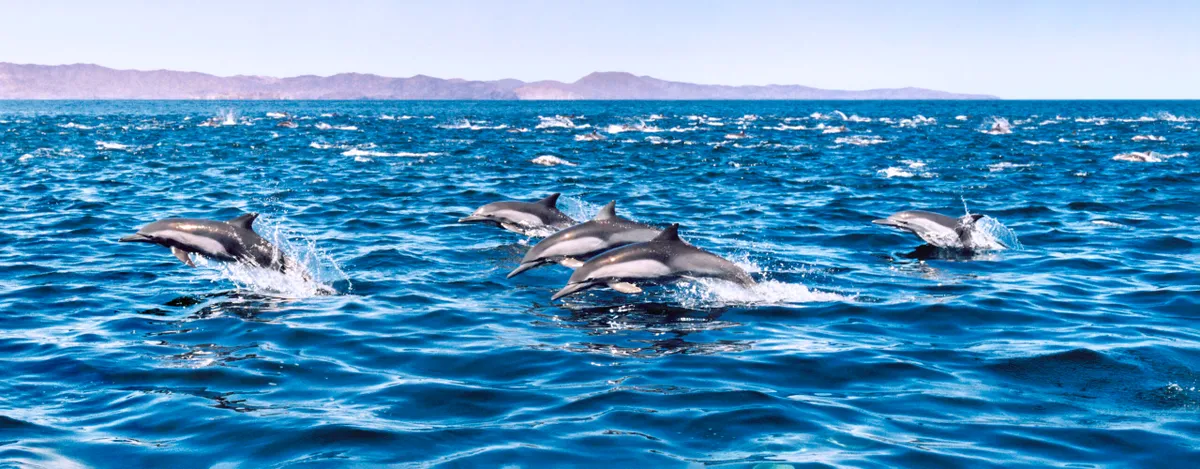There are currently around 90 recognised species of whale, dolphin and porpoise in Earth's oceans. They share similarities - and they have a lot in common with us, too.
All are mammals, have warm blood, and breastfeed their young with milk. They also all breath air, so have to regularly pop up to the surface.
Unlike humans, whales and dolphins are conscious breathers, which means they must be awake to take a breath, and they use sound underwater to communicate, find prey, socialise and navigate.
What's the difference between whales and dolphins?
There are lots of differences between whales and dolphins, too - but it can get complex. To begin with, which species do we even call ‘whales’?
The term whale or dolphin doesn't tell us an awful lot and we should really look at them all collectively as whales - either baleen whales (see below) or toothed whales. However, for the purposes of this article, we will separate them into the whale or dolphin camps.
How to tell the difference between a whale and a dolphin

One of the more obvious differences between dolphins and whales is size. In general, whales tend to be bigger than dolphins, and both are bigger than porpoises (all three classed as cetaceans). The biggest creature on the planet is the blue whale, measuring around 30m in length and weighting 150,000 kg.
The biggest dolphin is the orca. Also known as the killer whale (we said it could get complex), orcas measure nearly 10m in length and weighing 6,600 kg.
What do porpoises look like?

That leaves the little porpoise. Smaller than dolphins, there are seven species. They tend to be less than 2.5m (8ft) long. They are also characteristically chunkier than dolphins and have a small head, little or no beak, and a small triangular dorsal fin (with the exception, of course, of the finless porpoises).
Do whales and dolphins have teeth?
Now, back to the dental differences. Teeth are a great help if your daily diet is octopus and larger fish. But even teeth differ. Porpoise teeth are spade-shaped, whilst dolphins are conical. When it comes to whale teeth, some have lots, some only have a few, whilst others have none.
Whales with no teeth are known as and feed on smaller foodstuffs such as krill and plankton. They have no need for teeth. Instead, the fringed plates (baleen) hanging inside their mouths are used to strain seawater for food. The are 15 species of baleen whale, including the blue whale, and they are sometimes referred to as the ‘great whales’ due to their overall larger size.
Another visible difference is the blowhole. Baleen whales have two blowholes, whilst toothed whales (as well as all dolphins and porpoise) have one.
Do whales and dolphins share the same habitat?

On the social front, dolphins tend to hang out in groups or pods, whereas whales are likely to be more solitary. Dolphins are found more in shallower waters closer to shore.
Whales can hold their breath for longer periods of time than dolphins, with some species able to stay underwater for up to two hours. This enables them to dive down in the deeper ocean spaces.
Whilst some smaller whales, such as the beluga, can drift into river estuaries, there are species of dolphin that only live in fresh water rivers and lakes – the boto and the South Asian river dolphin are two examples. Some dolphin species move between fresh and sea water habitats, such as the tucuxi, the Irrawaddy dolphin (which we named one of the weirdest animals in the world) and the finless porpoise.
There are some dramatic differences in lifespan, too. For example, the harbour porpoise can live to around 12 years, whereas bowhead whales have lived to 200 years. Imagine the tales they could tell.
How long can a dolphin dive for?
Bottlenose dolphins routinely dive for five or so minutes, though they can push that up to 14 minutes on deep dives in search of squid. In the same family, orcas can last at least 55 minutes on a single breath. But there is a good argument for treating all the toothed whales as dolphins, because bottlenoses are more closely related to narwhals, belugas and beaked whales than to some species that go by the name of dolphin.
On that basis, Cuvier’s beaked whales can hold their breath longer than any other dolphin (or mammal) – up to three hours and 45 minutes, reaching depths of nearly 3km.
How intelligent are whales and dolphins?
Both whales and dolphins are smart – possessing high intelligence and using complex communication systems. It’s hard to compare the intelligence of a whale or a dolphin with our own, mainly as we can’t use the same methods to measure both. But they behave in ways that suggest a sophisticated mind.
Not only do they learn as individuals, but they can pass their knowledge onto others. It has been said that play is a great expression of intelligence, and whales and dolphins are gold medallists in this field.
Pods of dolphins leap, tumble, back flip and spin together; and there is often no explicable reason for this behaviour other than pure social enjoyment. There are even cases of whales and dolphins playing together.
- Why do spinner dolphins spin?
- Is it ever ok to swim with dolphins?
- Why dolphins like to follow boats and surf the bow waves
The ability to recognise yourself in a mirror (mirror test) is often used by developmental psychologists as a measure of intelligence and self-awareness. This skill is rare and a test that some dolphins pass with flying colours. Besides humans, only bottlenose dolphins, chimpanzees, elephants and magpies have been shown to recognise themselves in a mirror.
Whale and dolphin brains contain specialised brain cells called spindle neurons. These are associated with advanced abilities such as recognising, remembering, reasoning, communicating, perceiving, adapting to change, problem-solving and understanding. They appear to be deep thinkers.
Scientists agree that whales and dolphins communicate in sophisticated and, at times, novel and interactive ways. For some, such as bottlenose dolphins and orcas, the complexity of their communication and social interactions is immense; they are incredibly chatty.
- How to help a beached whale or dolphin
- What happens to dead whales?
- Why whales and dolphins don't suffer from the bends
So, there you have it. There are lots of similarities between whales and dolphins and lots of differences, but one thing is certain – when it comes to these mysterious creatures of the ocean, we humans don’t know the half of it.
There is so much more that we have to learn from and about them, which is why they fascinate us and why we need to protect them and the places they call home.
We are now discovering more and more about their important role within ocean ecosystems. By regulating the food chain, generating and moving nutrients through the water, and by capturing carbon, they help keep the ocean healthy, and a healthy ocean is vital in our fight against climate breakdown.
Images: Getty Images

